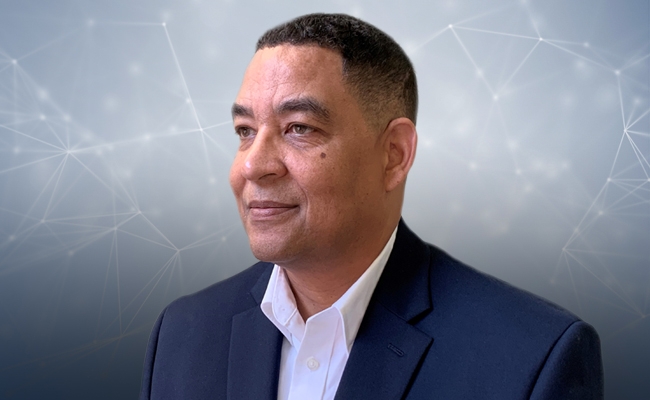Tetra Tech’s Vincent Holloway Discusses Advanced IT Solutions for the U.S. Department of Defense
Acquiring and delivering advanced information technology solutions to the U.S. Department of Defense
Published 06-22-20
Submitted by Tetra Tech

Vincent Holloway is Vice President, Defense Information Technology (IT) Services in Tetra Tech’s Arlington, Virginia, office. He has more than 30 years of experience working with the U.S. Department of Defense (DoD) in various technical, management, and leadership positions. His experience includes more than 20 years as an Army Signal Corps Officer in technical and tactical assignments around the world, including his final assignment at the Defense Information Systems Agency. Vincent also worked with clients as a DoD and Army consultant for 15 years on the development, acquisition, and deployment of enterprise IT solutions across echelons. Throughout his career, he has demonstrated expertise in IT law and policy, technical program management, operational testing, telecommunications and network engineering, software acquisition management, and tactical network operations.
Vincent holds a bachelor’s degree in Electrical Engineering from the University of Kentucky, a master’s degree in Business Administration from Boston University, a law degree from American University, and a Master of Laws degree from Hofstra University.
What is your background in the DoD?
I started as an Army Signal Corps Officer and worked in various command and staff assignments over a 20-plus-year career. My first job was as an electrical engineer testing Army radio systems, most notably the SINCGARS radio. I learned quickly that I did not like being stuck in the lab and moved on to tactical and technical assignments where I remained for a large part of my career. I have had significant experience leading soldiers and managing tactical operations from platoon to corps signal brigade levels. I loved working and being with soldiers. In between my tactical assignments at Fort Gordon, Germany, and Fort Hood, I had the opportunity to lead teams and organizations responsible for developing Army software products, testing C3 systems, and conducting oversight of DoD IT programs and operations. Since retiring from the Army, I have continued supporting the DoD in various program management and strategic consulting roles in policy development, enterprise IT operations, and system acquisitions.
What changes have you seen in how the DoD develops and deploys new technology to the field?
Early in my career, I was on the receiving end of many equipment fieldings. Some of the equipment worked and some of it we left in the motor pool. Back then, I never really understood the process of acquisition decisions and the behind-the-scenes technical trade-offs. In the tactical world, we began to see improvements when the Army established the Acquisition Corps and the DoD issued the DoD 5000 series of directives and instructions. When implemented, DoD 5000 was a major improvement, but resulted in fielding obsolete technology because the process was longer than the technology cycle. The DoD quickly learned it just could not afford to keep pace with communication and IT using the then-current requirements and acquisition processes.
Today, the DoD is fielding IT faster now than at any point in their history. They are leveraging their authorities to tailor acquisitions and speed capabilities to the field. It appears that government and military solicitations are adopting open source technologies, commercial standards, and best practices, which is a good thing. This shift is resulting in commercial technology solutions driving operational capabilities rather than operational requirements driving military technology development. It enables the government to buy the latest technology off-the-shelf rather than to develop the technology from scratch. In the world of IT and cyber, this is a major and significant shift. I think the Army’s approach of using capability set fieldings and the integrated tactical network is the right one which is giving our soldiers the superior technologies and tools in a timely manner to fight and win in the cyberspace domain.
What do you see as the biggest challenge facing the DoD as it deploys IT into the cyber domain?
There are many challenges. We must remain keenly focused on securing our data, platforms, applications, systems, and services within and outside the DoD Information Network (DoDIN). I read a report that said the DoDIN gets more than 1 billion daily intrusions into its networks. So, keeping pace with the dynamic, emerging threats in cyberspace, and deploying technologies to ensure our freedom of maneuver in cyberspace will continue to be a challenge. These technologies include hardware and software solutions designed to detect, identify, and respond to friendly and enemy actions that deny us full use of the cyber domain and interfere with the Department’s ability to execute warfighting, business, and intelligence operations. As I see it, the biggest challenges are selecting the right technology solutions, integrating the solution into the network architecture, scaling the solution across the enterprise, and then continuously updating the capability to meet emerging and future threats.
What do you think is the next major leap in defense industry communications and IT?
If I knew the answer to that question, I would patent it. Artificial intelligence, machine learning, autonomous systems, cybersecurity, and 5G Wireless continue to be the buzz and focus across the DoD. You also see discussions around browser isolation, assured identity, robotic process automation, blockchain, and software-defined radios and networking. All are important technologies, but I would challenge the defense industry to think more broadly. How about assured mobile connectivity? How about space-based computing platforms and services? How about software-defined everything?
I can envision a future where there is no need to deploy a terrestrial network because it is already there. Where commercial and military IT has indistinguishably converged into a single capability where ground, sea, and air mobile forces just turn on their equipment and they are securely connected to a global information infrastructure. I can also envision a future where there is no fixed, ground-based communications or computing infrastructure on the battlefield. An environment where unmanned tactical networks are flown into an area of operations, hover in the atmosphere during an operation, and redeploy for use in other operations. While we should continue to develop ground-based capabilities, the real leap in warfighting communications technology will likely occur in space to provide assured connectivity to data, storage, and computing power globally.
How can Tetra Tech help defense clients solve their IT and cybersecurity challenges?
I think Tetra Tech’s Leading with Science® approach really captures what we bring. Using science and engineering disciplines and methodologies, we endeavor to take the guesswork out of decisions for our clients. Tetra Tech provides information assurance, information systems security, certification and accreditation, risk management, and other security services. We have worked with organizations across the DoD, including the Joint Staff, Joint Staff Support Center, Defense Logistics Agency, Missile Defense Agency, and the Services. Our expertise and innovative approaches help our clients understand their system, application, and network vulnerabilities, and enable informed decision-making about mitigation strategies to protect their enterprise IT infrastructure.
We also have significant experience in application development; data analytics; cloud engineering and operations; public key infrastructure; certification and accreditation; network operations; intrusion detection; incident response; and computer forensics across the federal space. We have helped clients such as the Federal Aviation Administration, National Science Foundation, the Department of Veterans Affairs, Department of State, and the National Aeronautics and Space Administration understand the health of their IT enterprise, see and respond to actions and activities on their systems and networks, and most importantly, ensure they are not used as an attack vector into our national information infrastructure. As IT capabilities and disciplines converge onto the Cyber domain, Tetra Tech brings broad knowledge and experience across federal government IT and proven approaches and solutions that can be readily applied to the unique environment of the DoD.

Tetra Tech
Tetra Tech
Tetra Tech is a leading provider of high-end consulting and engineering services for projects worldwide. With 27,000 associates working together, Tetra Tech provides clear solutions to complex problems in water, environment, sustainable infrastructure, renewable energy, and international development. We are Leading with Science® to provide sustainable and resilient solutions for our clients. For more information about Tetra Tech, please visit tetratech.com or follow us on LinkedIn and Facebook.
More from Tetra Tech

